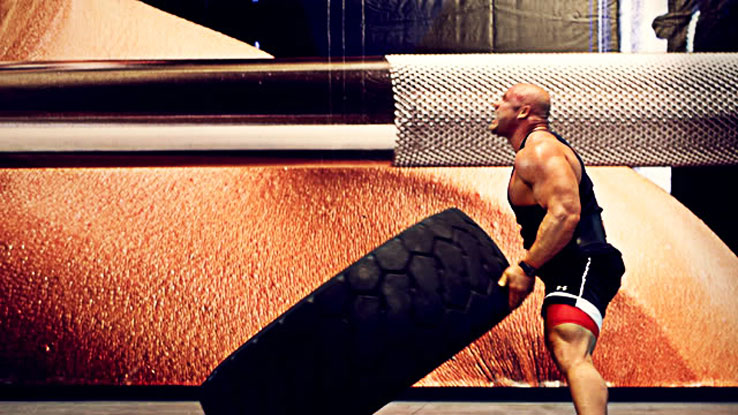You walk onto the gym floor ready to dominate another tough leg day. You're armed with a well-worn belt, knee wraps, a Nalgene bottle full of Surge® Workout Fuel running through your veins to make a three-toed sloth do cartwheels.
You and your partner methodically go through your warm-up sets an empty bar, 135, 185, 225, 275, 315, etc. Despite the increasing loads, each set looks deeper, stronger, and more explosive than the last. Your nervous system is ready. Your joints are ready. It's go time. You take another swig of your drink and get set to attack your big set of squats scheduled for today.
"We've got 390 for five today," you tell your buddy.
"Didn't we do 370 for five last time?" he asks.
"I don't think so," you reply. "We hit 380 last time, right?"
"Nah, 370," he says. "We were going to try for 380 but we were having a rough day, remember?"
"So we should hit 380 today?" you ask, your confidence starting to waver.
You stare at one another dumbfounded, each waiting for the other to blink. You break first. "Let's just hold at 380 and save 390 for next week. We'll kill it then."
As you leave the gym an hour later exhausted and limping, you can't help but think about what could've been. You know you hit 380 last week. If only there was a way to have known for sure.
Don't let this happen to you. If you're serious about lifting, you need to keep a workout log. The workout log can reveal patterns of strength development, weight change, mental attitude, overtraining, and plateaus clearer than the most committed training partner. Every session, every set, and every rep you do in the gym should be recorded. Here's why:
1 An Accurate Record
First, the log keeps an accurate record of what you really did. Even if you think you have a near-photographic memory when it comes to your sets and reps, I'll bet you've made mistakes in the past and either repeated a weight or made too large of a jump and messed up the routine.
Sure, you might remember your big, fat PR sets; but do you remember your second set of lateral raises three weeks ago? The log takes care of that for you.
2 A Blueprint to Success
Next, if you experience great results with your training – and I hope you do – the log becomes a blueprint for what works for you. If your squat went up 40 pounds in two months following my squat program, then there's a strong chance that repeating that workout at some point will make your squat go up again.
It's not a guarantee and nothing lasts forever, but it's a safer bet than just following a favorite program from some gym buddy who's never seen a bottle of anabolics he didn't like.
If you don't experience positive results, the good news is that you can learn something from that as well. Not getting results teaches you what doesn't work, and while it sucks to bust your butt in the gym for a few months and make little progress, at least you learned what not to do.
3 A Teaching Tool

For many, the very act of taking notes is a powerful learning tool. I teach a lot of students every year and give many lectures. During those lectures some students take notes and some don't. Guess who performs better on the tests? The note-takers.
Writing down the workout you just completed, thinking about it, analyzing it, helps ingrain that information in your head. It never fails to amaze me when I talk shop with serious lifters that can't answer simple questions such as, "What's your best 5RM squat?"
Those that keep a log can rattle off answers to these type of questions like Rain Man because they "studied" it already by writing it down. And if they don't know, they can at least look it up in short order.
4 A Written Motivator
A workout log can also be very motivating. You can look back a month or a year into the past and see that your toughest set back then is your first easy work set now.
This is what also makes a workout log very rewarding. There are few areas in life where you get the sort of constant and objective feedback that weight training provides. Every set and rep is invaluable data about your progress; all you have to do is interpret it – and when the overwhelming majority of it is positive, that can go a long way towards building confidence and self-esteem.
It's empowering to start off not so good at something and build proficiency through nothing other than basic hard work.
5 Injury Prevention
Workout logs can help predict and even prevent injury. When injuries occur you can go back through your log and see if you can identify why – too much volume, ignoring nagging signs of injury, too much load before you were ready, whatever.
Once you can pinpoint what affects you negatively, you can (hopefully) plan things out so you're less likely to have similar problems in the future.
6 Client Record
If you're a trainer or a coach, keeping a workout log for your clients/athletes becomes even more important. It serves as an accurate record for any sort of liability issues, which are rare (thankfully) but can happen, and can also serve as a billing record for how many sessions were rendered in a certain time period.
Not to mention as your business grows, it can become difficult to remember all the little details for each client, making a clear log book even more important to a busy trainer.
7 The Big Guys' Secret

Finally, watch the really serious lifters in your gym, especially the accomplished powerlifters and strength athletes, and see how many record their workouts. That's the best reason of all.
I've been keeping track of my workouts for over 15 years and I can tell you there's a direct correlation between the quality of records kept and the success achieved under the bar.

Hopefully you've bought into why you should keep a log. Here's a guideline on how to do it.
I'm a results oriented guy, so if you have a method that works for you, great, but here are some suggestions you might find useful.
Get a decent notebook to be your workout log. You can spend $15 on a preset workout log, but I find most to be limiting. For example, it can be annoying if they only have space for three sets or six exercises per day and you usually do more.
I like just a blank 8x10 college notebook. You want one with sturdy covers and rings that will stand up to the abuses of time and being tossed about inside your gym bag. Expect to spend five bucks (not two bucks, you cheap bastard) and look for one where the sheets don't tear out easily.
I find recording one workout per page to be best. It feels good to save paper and all, but it's much simpler to find previous sessions when you stick with just one day per page. Plant a tree in your backyard if the guilt starts to wear on you.
With each workout, record the day of the week and the date itself. Knowing the day helps with finding things. For example, you might need to find something that you only do on Mondays, and you likely won't remember in April that the 16th of January was a Monday.
Record your bodyweight each day. This is a simple yet fairly important variable. You might know your general bodyweight over the years, but if you look up something cool you did – say you rocked out 30 pull-ups two years ago – it would be nice to know your actual bodyweight that day to better help understand your performance. Recording your weight regularly also goes a long way to teaching you how your body responds to food.
Write down everything, including warm-up sets, stretches, etc. If you have a great day and hit a new squat PR, it would be helpful in the future to know how you prepared for that set. That way if it was 10 minutes of mobility followed by a certain number of warm-up sets, you can duplicate that exact day, which is the point of the training log.
A good rule of thumb is, if you can read your log and duplicate the workout exactly, you've recorded enough info. If you can't duplicate the workout or have forgotten something, the workout log isn't detailed enough.
Don't forget to note any settings or adjustments to the exercises. Performing an incline press at 45 degrees is a lot tougher than 20 degrees, and that should be noted. Write down the weight lifted x the reps performed; it's usually in that order (so 12 x 8 means 12 pounds for 8 reps). You can write down each set or indicate something like 12x8x3 (meaning 3 sets of 8 reps were performed with 12 pounds).
If you received help on some reps or your form really changed, indicate that. A '+' sign works great for this. So 100x10+2 means 10 good reps were completed with 100 pounds along with 2 additional forced reps. A '–' sign works well for negatives, so 300x3-2 means 3 normal reps followed by 2 negatives.
Take as many notes as possible. I've never looked back at my logs and cursed myself for having too many notes, but there were days I wished I'd written more info.
If something is bothering you (bad shoulder, back, knee, whatever) indicate that. You might use an RPE (Rate of Perceived Exertion) chart to indicate difficulty of important sets. Recording heart rate and total time of an activity or rest can be very useful if you're into cardio or conditioning.
If exercise form is so-so or you required a spot you can indicate that. If you're feeling sick or down that info can be useful to know, too. I like to record the total time of the workout as well so I can quickly better gauge the overall speed of the program.
Each year start a new workout log. You might lose it or it gets ruined; this way the most info you ever lose is just one year. Most logs tend to fill up after a year of training anyway so that timeframe seems to work well.
Below are some pics of how I set my stuff up. Feel free to copy it or just set up your own system, whatever works best for you.

Weightlifting legend Tommy Kono said it best 40 years ago: "The palest of ink is better than the clearest of memories." If you haven't been keeping a workout log, it's never too late to start.
If you have been keeping one, I know you're not going to stop – and that might be the most compelling reason of all to keep one. How many people do you know started to keep a log, kept lifting seriously, and then decided it wasn't worth the effort to keep a log? Exactly.





